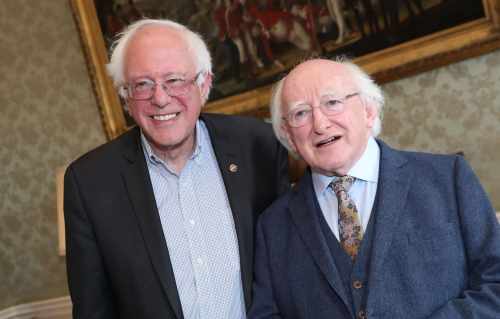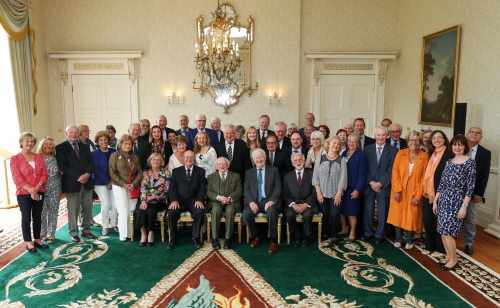Speech at the Opening of Shekina Exhibition
Shekina Sculpture Garden, Glenmalure, Co. Wicklow, 9th June 2017
Dear friends,
A chairde,
Is mór an pléisiúir é dom a bheith anseo ar maidin sa ghairdín dealbh draíochtúil seo "Shekina", áit a bhfuil áilleacht ealaíonta agus nádúrtha ag baint léi agus a bhfuil ina tearmann síochánta athchuimhne agus inspioráide. Is mian liom mo bhuíochas a ghabháil le Catherine McCann agus leis an Roinn Ealaíon, Oidhreachta, Gnóthaí Réigiúnacha, Tuaithe agus Gaeltachta dá gcuireadh dom an taispeántas dealbhóireachta seo a oscailt.
It is my pleasure to be here with you all this morning, in this enchanting sculpture garden, Shekina, a place of artistic and natural beauty, and an oasis of peace, recollection and inspiration. May I thank Catherine McCann and the Department of Arts, Heritage, Regional, Rural and Gaeltacht Affairs for their kind invitation to open the Shekina sculpture exhibition. Catherine McCann has been at once the architect, the patient carer and the guardian spirit of this exquisite garden for more than three decades, and I would like to avail of this opportunity to thank her for the all work and the attention she has given to this place, day after day, for the delight of all.
I am particularly delighted to be able to come back to Shekina after twenty years, and to see the new sculptures that have been added to the garden’s collection. I was Minister for the Arts, Culture and the Gaeltacht when Catherine McCann gifted the Shekina Garden to the State, a transfer which I formalised on the occasion of a visit to this place in 1997. This visit was, in fact, one of the last duties I performed on my final day as a member of cabinet.
Shekina is the quintessence of what a garden represents for us human: a space within which the living nature, artistic aspirations and the imagination meet, a place which convokes ideals of beauty and pleasure – of paradise even. Illustrations of this are to be found throughout history and across cultures. In the Middle Ages, for example, many European gardens were enclosed within walls and they harboured a multitude of symbols alluding to a lost Eden. Conceptions of heaven are also at the heart of the magnificent Arabic gardens, with their fountains and shady archways. We can think, too, of the rich symbolism of the idealised “dried landscape” of the so-called zen gardens which flourished around Japan’s zen Buddhist temples in the 14th and 15th centuries.
The concept of the garden, then, in both its history and its etymology, suggests a bounded space, separated from the untamed wildness of nature, and yet expressing a dialogue – both spiritual and physical, between man and nature. The Shekina garden, located as it is at the threshold of the wild Glenmalure Valley, thus offers itself as a sort of templum, opening onto wide vistas of the rugged Fananieran Mountain sides, while at the same time concentrating and exalting the great possibilities of human work, imagination and creativity, in the fullness of their relation to the natural world.
Here is a place – a small place, of no more than one acre – that invites us to a vast meditation on the joys, but also the mysteries, of creation, in every sense of the word. We are invited to become mindful of an order of life greater than us, as well as being enticed to marvel at a form of artistic creation which draws both its inspiration and its texture from that magnificent, nurturing and immensely generous nature in which we dwell. The twenty sculptures contained in this exhibition, all of them by modern Irish artists, strike us by the very matter of which they are made, whether it is raw natural material, such as wood and stone, or alloys such as bronze, cast iron, and steel, or mixtures such as glass and enamel, all of them transformed, transfigured and transubstantiated, by the work of the human hand and imagination.
These works of art we are celebrating today do not merely belong to the realm of representation and artifice. All of them also evoke and embody a harmonious relationship between the artist's creative endeavour and nature's beauty. That deep sense of harmony stems, as I have just said, from the shape and texture of the sculptures in the Shekina collection, but also from their position in the garden. As the excellent catalogue published for this exhibition puts it, each sculpture has, over time, "grown into the garden, just as the garden has embraced each sculpture.”
Such fascinating – and, let us not forget, age-old – dialogue between art, nature and the invisible powers of the spiritual is splendidly incarnated in the work of Fred Conlon, and in the three pieces of his work on display in this exhibition. I am very pleased to see that one of these sculptures, which was generously made available on loan by Kathleen Conlon, has been placed in the community, in a position to be seen by the many walkers, hikers, cyclists and motorists who take the nearby road to the valley of Glenmalure.
Fred Conlon, as some of you may know, spent his childhood in the townland of Killeenduff, near Easky, in County Sligo. The son of a landless farmer, he experienced the hard world of subsistence living but also the joys of a life lived in close proximity to the natural world. His early and exceptional talent owed him a scholarship to the National College of Arts, a rare achievement for a young man of modest rural extraction in the Ireland of the late 1950s.
According to Fred Conlon’s cousin and biographer, Jack Harte, it was his attendance of a lecture by Françoise Henry on early Irish stone sculpture, from elementary megalithic carvings to the complex patterning of high crosses, which influenced Fred’s artistic direction and his passion for stone carving. Fred Conlon’s artistic practice was one that was intensely physical and committed; indeed the hard labour of carving, cutting, chiselling, drilling, incising, pitching, polishing and carrying did in time take its toll on his muscles and joints, and on his general state of health.
The art of making in granite or bronze or oak is, surely, one that demands a particular cast of mind and body. One cannot easily trifle in such stern materials. The act of sculpting, the process of creation and the unfolding vision of the artist from a block of rough material indeed calls for exceptional aesthetic spirit and courage.
Fred Conlon’s work offers a remarkable illustration, may I suggest, of the encounter between the sensible and the invisible which has been at the heart of the art of sculpture since ancient times, from Egypt and Greece, to India and indeed to ancient Ireland. Inspired by pre-Christians and early Christian stone carvings, Fred Conlon’s work is one in which spiral and curvilinear forms recur. As he himself said:
“My work has been in conjunction with the spiral. The centre is everything. There is nothing without a point of energy. There is in nature and man a great centre of force.”
The presence of such rich symbolism of the heart of this small garden resonates with the promise held in the beautiful name Catherine McCann has chosen for it: Shekina, a Hebrew word pointing to the dwelling of the divine in a place. In the commentary she wrote for the exhibition catalogue, the eminent art historian Paula Murphy describes how Shekina has the theme of creation as the underlying source of its inspiration, and how the attention of the visitor is drawn to a symbolism which is sometimes religious in content, but not necessarily, and never exclusively.
The word that matters here, may I suggest, is that of “attention”. Shekina is a place which calls upon us to pay attention to the world around us, to be attentive to its beauty and also, perhaps, to the webs of meanings that hold it together, for us, humans. Here, we are invited, even more primarily, to slow down, to sit on one of the small benches placed in the nooks of the garden, and recover a capacity for silence and full attention.
Mar fhocal scoir, may I thank all those who tend to this garden – Catherine McCann, of course, but also those in our National Parks and Wildlife Service, who play such a crucially important role in preserving and enhancing Ireland’s natural heritage for the benefit of this and future generations. May the coalescing forces at play here at Shekina continue to enable as many visitors as is possible, or reasonable, to be exposed to the unique experience of the eye of the artist interpreting, re-presenting and animating the wonder of nature. Ours are times when that instinctual alliance between the artist and the cause of nature is, indeed, more needed than ever.
For nature and art are, after all, what make our world truly hospitable – truly habitable.
I ndeireadh na dála is iad an nádúr agus an ealaíon a dhéanann an domhain mórthimpeall orainn fáilteach agus ináitrithe.


